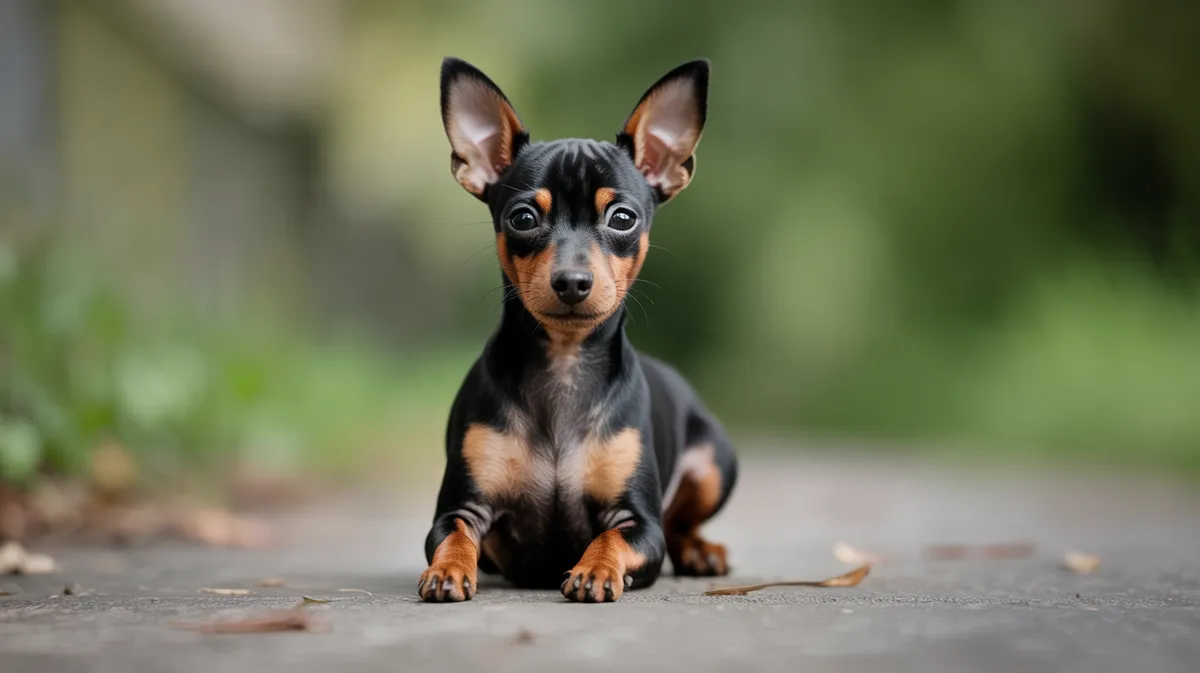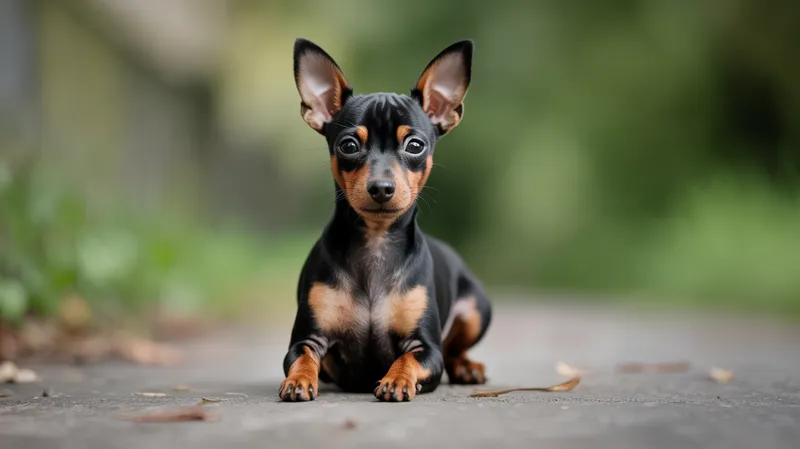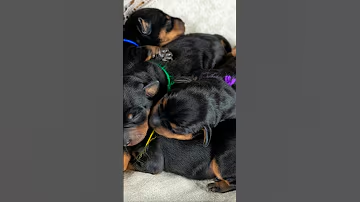
Miniature Pinscher
Canis lupus familiaris

Meet the Miniature Pinscher
The Miniature Pinscher is a small, spirited breed of dog known for its lively personality and sleek, compact build. Often referred to as the 'King of Toys,' this breed boasts a confident, fearless demeanor despite its diminutive size. Originally bred in Germany, Miniature Pinschers were developed to hunt vermin, particularly rats, in homes and stables. Their high energy, intelligence, and alertness make them excellent watchdogs, and they are easily recognized by their smooth coat, distinct hackney gait, and proud, upright stance.
Classification
Mammal
Habitat
Domestic (Human homes and urban environments)
Diet
Omnivore
Lifespan
12-16 years
Conservation
Least Concern
Weight
4-6 kg
📖Fascinating Facts
Not a Mini Doberman
The Miniature Pinscher is often mistaken for a smaller version of the Doberman, but they are actually a separate, older breed with distinct origins.
Excellent Watchdog
Despite their small size, Miniature Pinschers are alert and vocal, making them effective watchdogs for families and homes.
Distinctive Gait
This breed is known for its 'hackney' gait, a high-stepping prance usually seen in horses, adding to their unique and charismatic appearance.
📋Detailed Description
The Miniature Pinscher (Canis lupus familiaris), often called the 'Min Pin,' is a compact, well-muscled toy breed characterized by a square, balanced frame and a sleek, short coat that comes in colors such as black and tan, chocolate and tan, stag red, and solid red. Adults typically stand 25–30 cm (9.8–11.8 in) at the withers and weigh between 4–6 kg (8.8–13.2 lbs). The breed is distinguished by its high-stepping, 'hackney' gait, a trait selected for both aesthetic appeal and agility. Anatomically, the Miniature Pinscher has a wedge-shaped head, dark, oval eyes, and high-set, erect ears (often cropped in some countries). The tail is customarily docked, though this practice is declining. Behaviorally, Min Pins are alert, energetic, and fearless, displaying a pronounced territorial instinct and a tendency to vocalize when sensing intruders. Socially, they are loyal to their families but can be reserved or assertive with strangers and other animals. The breed is highly intelligent and trainable, though independent and sometimes stubborn, requiring consistent, positive reinforcement. Reproductively, females typically have 2–4 puppies per litter, and the breed is known for its robust health and longevity, often living 12–16 years. Their keen senses, especially hearing and smell, are adaptations from their historical role as vermin hunters, and they remain highly active and inquisitive, necessitating regular mental and physical stimulation.
💡 Did you know?
Despite their toy size, Miniature Pinschers are exceptionally skilled escape artists and can find their way out of fenced yards or closed spaces if not properly secured.
🔬Research & Sources
Wikipedia Summary
The Miniature Pinscher, also known as the Zwergpinscher, Mini Pin and Min Pin for short, is a small breed of dog of the pinscher type originating in Germany. While the breed's visual similarities to the Toy Manchester Terrier, which somewhat resembles the Pinscher breeds, remain a matter of controversy, genetic research has shown that the two breeds have shared, unique ancestry. The ancestors of the Toy Manchester and Miniature Pinscher may have become geographically separated many centuries ago and retained similarities simply through breeding selection for the same traits; nevertheless, the 2017 research also showed that the two breeds remain more closely related to each other than to other breeds. The breed's ancestors may also include the German Pinscher, Italian greyhounds and dachshunds. The Miniature Pinscher's known origins are in Germany, where it was often referred to as the Zwerg Pinscher in historical documents. German Kennel Club documents also refer to the Miniature Pinscher as the "reh" Pinscher, but this term is only used for a dog of stag-red color, "reh" referring to a small red deer formerly found in German forests. The Miniature Pinscher originated several centuries ago as an efficient barnyard ratter.
Last Modified: 6/2/2025
🎭Behavior & Social Structure
Miniature Pinschers are renowned for their bold, spirited demeanor and pronounced curiosity. They exhibit strong prey drive, a vestige of their origins as ratters, and will often chase small animals or moving objects. Their daily routines involve bursts of high activity interspersed with periods of rest; they enjoy interactive play, agility exercises, and exploratory walks. Socially, Min Pins form close bonds with their primary caregivers and can be protective, sometimes exhibiting guarding behaviors disproportionate to their size. They are generally good with children if properly socialized, though their assertiveness may be overwhelming for very young kids. Feeding behavior is typical of small breeds, requiring high-quality, portion-controlled diets to prevent obesity. Min Pins are quick learners but can be willful, necessitating early and consistent training to curb undesirable behaviors such as excessive barking or resource guarding. They are vigilant watchdogs, quick to alert their owners to any unusual activity.
👶Reproduction & Life Cycle
Miniature Pinschers reach sexual maturity around 6–9 months of age, though responsible breeding is recommended after 18 months. The breed does not have a defined breeding season, as domestic dogs are polyestrous, but most litters are planned for spring or early summer. Estrus in females lasts approximately 2–3 weeks, during which mating occurs. Gestation averages 63 days (range: 58–65 days), with typical litter sizes of 2–4 puppies, though larger litters are possible. Whelping is usually straightforward, but small breed complications such as dystocia can occur. Maternal care is pronounced; the dam nurses and grooms the puppies intensively for the first 3–4 weeks. Puppies are weaned by 6–8 weeks and should remain with the mother and littermates until at least 8–10 weeks to ensure proper social development. Responsible breeders screen for hereditary conditions such as patellar luxation and Legg-Calvé-Perthes disease.
🛡️Adaptations & Survival
The Miniature Pinscher's compact, muscular build and high-set, mobile ears are physical adaptations for agility and acute hearing, aiding in their historical role as vermin hunters. Their short, dense coat provides protection while minimizing grooming needs, an advantage for active, working dogs. The breed's distinctive hackney gait enhances maneuverability in tight spaces, such as barns and stables. Behaviorally, their high energy, vigilance, and territoriality are evolutionary specializations for detecting and deterring intruders or pests. Their intelligence and problem-solving abilities facilitate learning complex tasks and adapting to varied environments. The breed's boldness and self-confidence are adaptive traits that enabled them to confront larger prey and assert dominance in multi-dog households.
📚Research Sources
🎨Cultural Significance
The Miniature Pinscher holds a prominent place in European, especially German, canine culture, where it is celebrated as the 'King of Toys' for its regal bearing and spirited personality. Historically, the breed was prized for its vermin control abilities in stables and homes. In modern times, Min Pins are popular show dogs and companions, frequently featured in dog sports such as agility and obedience. Their image is associated with alertness, courage, and elegance, and they are often depicted in art and advertising as symbols of vitality and confidence. The breed has no significant role in mythology or folklore but is beloved for its unique personality and presence.
🔬Recent Research & Discoveries
Recent genetic studies (e.g., Parker et al., 2017) have clarified the Miniature Pinscher's relationships with other pinscher and terrier breeds, revealing a close genetic affinity with the Toy Manchester Terrier and German Pinscher, despite historical debate over their origins. Ongoing research focuses on breed-specific health concerns, such as the genetic basis of Legg-Calvé-Perthes disease and patellar luxation. Behavioral studies highlight the breed's intelligence, trainability, and suitability for canine sports. There is also interest in the breed's longevity and resilience, with some individuals living beyond 16 years. Recent advances in canine genomics continue to inform best practices for breeding and health screening.
🎥Wildlife Videos

World's Smallest Wild Dog | Dogs in the Wild: Meet The Family | BBC Earth
Barely the size of a walking boot, the Fennec Fox (Vulpes zerda) goes head-to-head with the Sahara. Against all odds, the ...
BBC Earth

How We Film Tiny Animals | Inside Big Little Journeys
Big Little Journeys filmmakers employ various filming techniques to capture two very different animals. Narrated by Aaron Pierre.
Nature on PBS

My MINIATURE PINCHER is PREGNANT! (Marvel)
Witness the miraculous journey of a miniature marvel as a pincher prepares for motherhood. In this captivating video, follow the ...
Pets Home Video

99% of Min Pin Owners Don't Know This
Did you know that Miniature Pinschers are often mistaken for miniature versions of Doberman Pinschers? But what distinguishes ...
Dogs Wiz

Nature Animal Miniature Pinscher Dog | Wildlife Animals| Best Animals compilation
Wildlife#Animal#african wildlife#nature#Soundtrack# Thank you for watching my Videos. I love to create videos to show you how ...
Nature-Animals

Tiny Titans - The Fascinating World of Insects | Free Documentary Nature
Tiny Titans - The Fascinating World of Insects | Wildlife Documentary Watch 'Wildlife - Just Insects' here: ...
Free Documentary - Nature
🌍Habitat Information
The Miniature Pinscher typically inhabits Domestic (Human homes and urban environments) environments. Miniature Pinschers have adapted to their environments with specialized features and behaviors.
Primary Habitat:
Domestic (Human homes and urban environments)
More detailed habitat information will be available soon.
🛡️Conservation Status
The Miniature Pinscher is currently classified as Least Concern. Conservation efforts are crucial for preserving this species for future generations.
Common Threats:
- 🏠Habitat loss and fragmentation
- 🌡️Climate change impacts
- 🎯Hunting and poaching
- 🏭Human-wildlife conflict
⚠️Threats & Conservation Challenges
As a domesticated breed, Miniature Pinschers face few natural threats, but they are susceptible to challenges common to small dogs, such as accidental injury, predation by larger animals, and health issues like patellar luxation, Legg-Calvé-Perthes disease, and dental problems. Overbreeding and irresponsible breeding practices can lead to genetic disorders and temperament issues. Miniature Pinschers are sometimes surrendered to shelters due to behavioral problems stemming from inadequate training or socialization. Urbanization and changes in human lifestyles have reduced their traditional role as ratters, but they remain popular as companion animals. The breed is not at risk of extinction and is classified as 'Least Concern,' with stable global population trends.
🔬Scientific Classification
Scientific Name
Canis lupus familiaris
Classification Hierarchy
🔍 About Taxonomic Classification
Taxonomic classification is a hierarchical system used by scientists to classify and organize living organisms based on shared characteristics and evolutionary relationships.
The system moves from broad categories (Kingdom) to increasingly specific ones, with each animal's scientific name typically consisting of its Genus and species.
📝Community Notes
Share your observations and insights about the Miniature Pinscher with our community of wildlife enthusiasts.
Join Our Community
Sign in to share your observations and connect with fellow wildlife enthusiasts.
Sign In to ContributeNo community notes yet
Be the first to share your observations about the Miniature Pinscher!
Explore Miniature Pinscher
Select a tab above to learn more about this amazing animal.
📸Photo Gallery
No photos available for this animal yet.
🌟Discover More Wildlife
Continue your journey of discovery with more fascinating animals from our database
